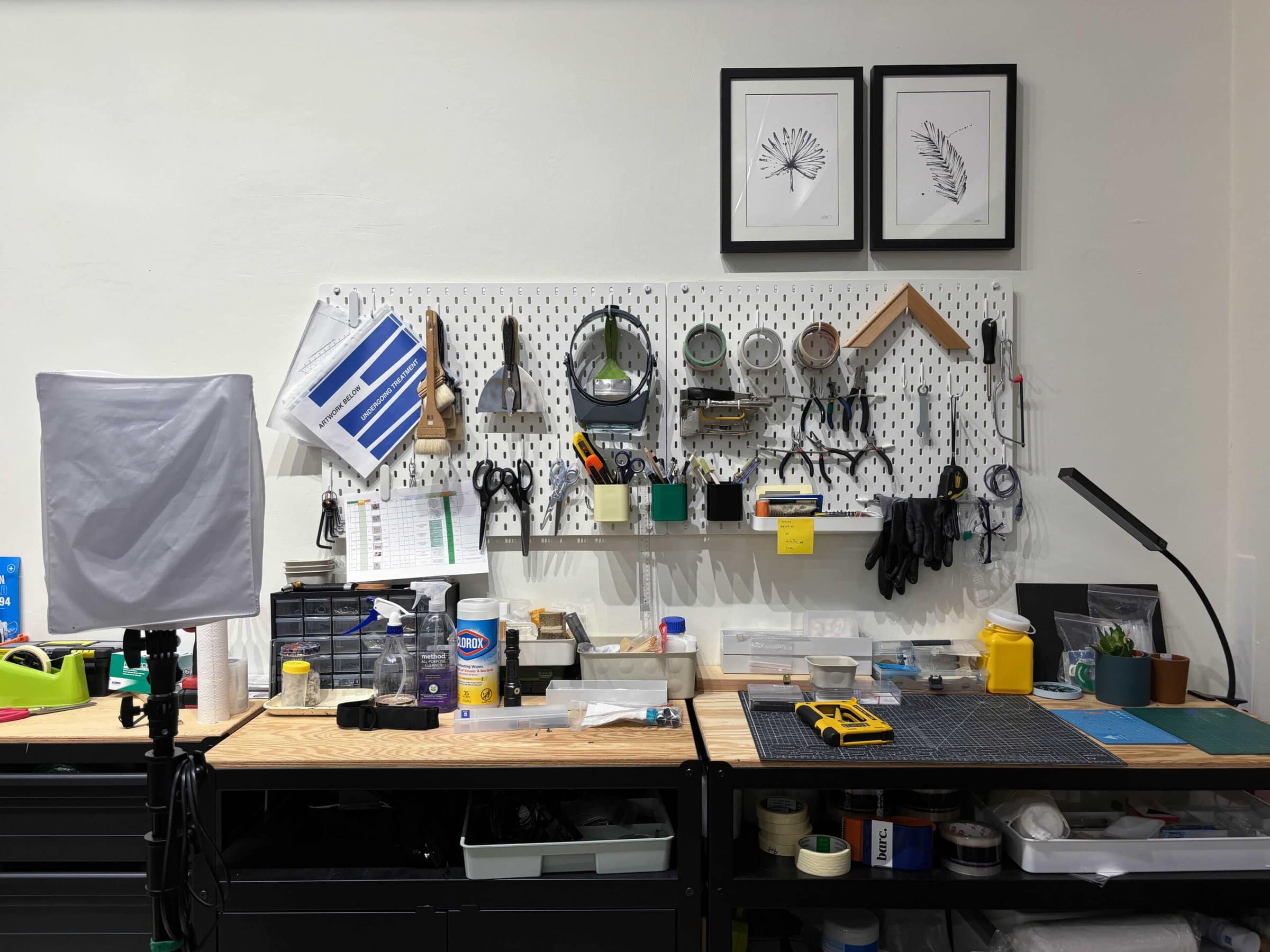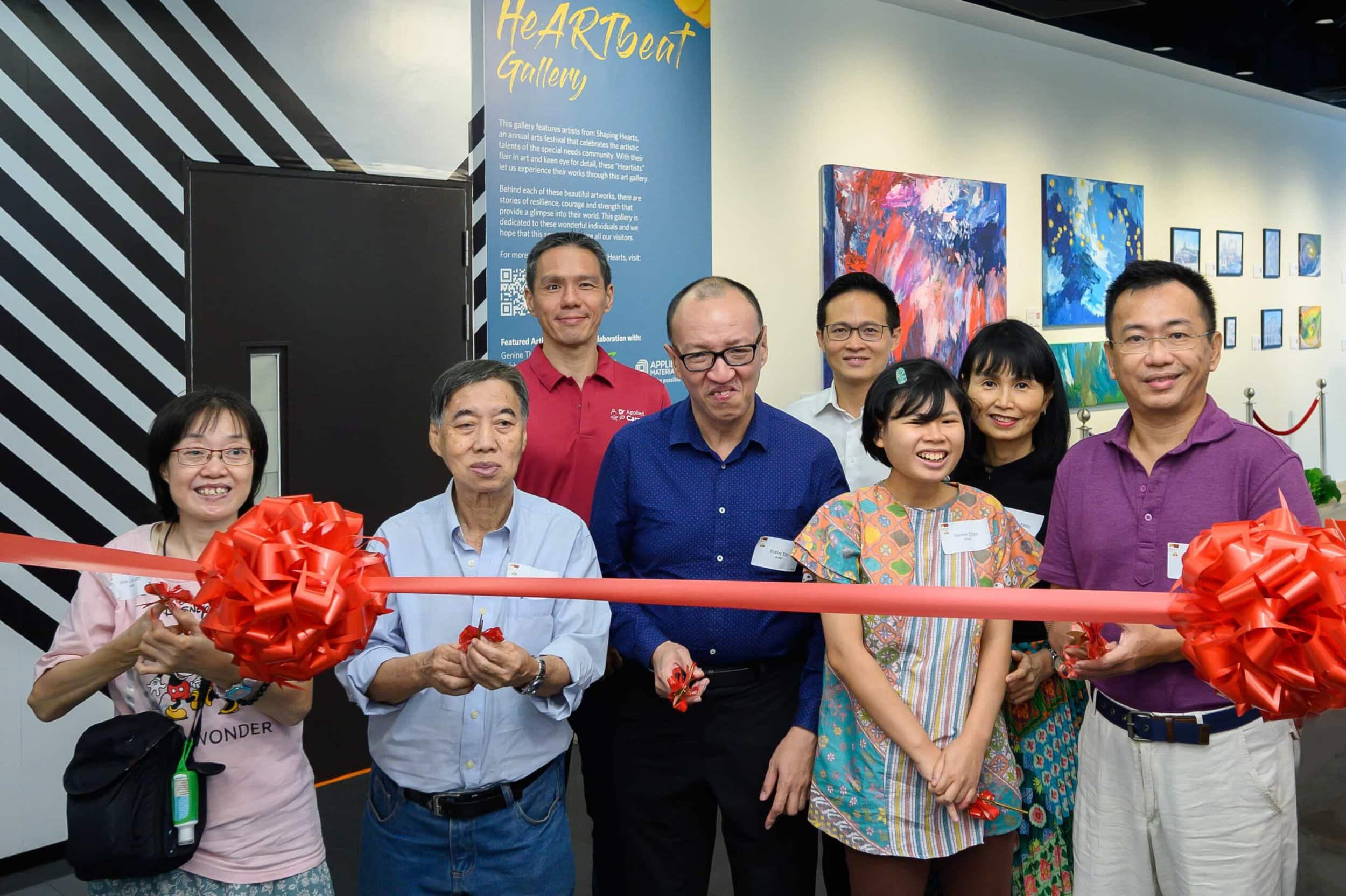Microscopes in a museum — an art museum, no less? You’d be forgiven for doing a double take upon entering the National Gallery’s latest exhibition of one of Singapore’s most celebrated artists. Adopting an innovative approach which spotlights artistic processes and materials through scientific and technical analysis, Cheong Soo Pieng: Layer by Layer showcases the unabashed stylistic and material experimentation at the heart of the artist’s oeuvre.
On view are works ranging from Cheong’s early oil-on-canvas portraits to multimedia works that blur the lines between painting and sculpture. And yes, if you’ve got a 50-dollar note on hand, now’s the time to compare the reproduction of Drying Salted Fish on it with the original on display.
Alongside artists such as Georgette Chen, Liu Kang, and Chen Wen Hsi, Cheong was a pioneer of the Nanyang school of painting, a movement now almost synonymous with modern art in Singapore. When exhibiting such an artist — widely known, regularly taught in schools, and deeply embedded in the dominant understanding of Singaporean art history — it’s not easy to break away from the usual cliches and say something new.
The ongoing exhibition, however, offers fresh angles on Cheong’s practice. While art historians have often focused on Cheong’s fusion of Chinese ink painting techniques with Western art styles, Layer by Layer brings scientific and technical analysis to bear on Cheong’s works, analysing not only style, but also the idiosyncratic textures and origins of Cheong’s materials. Audiences, for instance, are invited to touch swatches of jute, gunny sack, and straw mat, which Cheong used as supports for his paintings.

Moving away from the conventional model of presenting artworks on bare, white walls, stripped of any additional context, the exhibition instead looks more like a researcher’s laboratory, replete with instruments of analysis and material samples for comparison. Magnified cross-sections of Cheong’s early postwar portraits, for instance, reveal how he mixed different colours of wet paint on the canvas to build up a thick, textured surface.
When I visited the exhibition on a Sunday afternoon, I was heartened to see visitors of all ages lingering on the works — perhaps for a little longer than usual. Several children were peering excitedly into the microscopes, while their parents looked on with equal interest; couples milled around the gallery space, pausing to compare infrared photographs of the paintings with the originals on display.
It was clear that audience engagement and accessibility had been front and centre in the way the exhibition had been designed and curated, under the lead of project director Patrick Flores, curator Teo Hui Min, and principal researcher Diana Tay.

Accompanying the wall texts are videos in which experts share insights into Cheong’s artistic process and the research behind the exhibition. There’s also a touchscreen game which invites you to match cross-sections of paint to the parts of the painting from which they come.
With these interactive elements, Layer by Layer turns technical and art-historical research into easily digestible, bite-sized ideas. It’s a refreshing, educational approach to art that demystifies the artist’s processes, inviting us to put ourselves in his shoes and imagine how, for instance, running a brush over a coarse piece of fabric would’ve felt different from applying gouache to Chinese scroll paper.
Wanting to learn more about the research that went into the exhibition, I visited Dr Diana Tay in her studio to get a glimpse of the science and art of conservation.
Behind the scenes with a conservator
BARC Labs — the acronym is pronounced “bark,” and stands for “Beneath Art Research and Conservation” — is a fine art conservation startup that Tay founded in September 2022, shortly after she completed her PhD at the University of Melbourne and returned to Singapore.
“There’s a reason why the R comes before the C — because everything we want to do should be grounded in research,” says Tay. Thoroughly understanding the material components of an artwork, as well as how they change over time and in response to environmental conditions, are key parts of conservation.

“There are two methods of research,” explains Tay. “Think of it like going to the doctor. You have non-invasive techniques — maybe using a stethoscope, or an MRI, for example. And you have invasive techniques, like surgery.”
“For this exhibition we did a lot of non-invasive research, such as X-rays, and technical photography. [With these techniques], you don’t even have to touch the surface of the artwork.” Only the cross-sections in Layer by Layer involved invasive interventions.


After taking a cross-section, a researcher can then put it through a scanning electron microscope, which can magnify samples to almost 500 times their actual size and even identify the exact elements that make up each pigment.
“For us, a white is not [just] a white. Is it made of calcium? Is it made of titanium, lead, or zinc? Is it a blend? You are able to pinpoint [the components of paint] to that level with different machines.”
Scanning electron microscopy was a technique that Tay used in her PhD, for which she analysed 67 paintings by Cheong Soo Pieng and Georgette Chen. “But we didn’t present that in this exhibition because it’s too inaccessible. It would’ve been too much information.”

How then did Tay and the curators decide what to omit, and what to present?
“There was a lot of discussion with the curatorial team, because they are the experts in presenting public-facing exhibitions,” Tay explains. For instance, the team chose to place colourful paint cross-sections under the microscopes, rather than fibre samples, which would’ve been less visually engaging and harder to tell apart.
The curatorial process was thus a delicate balancing act, as the show had to speak to a general audience with limited technical knowledge, yet also nudge boundaries to expand their appreciation of Cheong’s work.
Layer by Layer brings together the best of two worlds, with curator Teo Hui Min’s art historical perspective complementing the scientific and technical analysis conducted by BARC Labs and the Heritage Conservation Centre (HCC).
“Soo Pieng is so varied, right? But his [approach to] material is quite consistent,” says Tay. While Cheong’s works are diverse in appearance, closer analysis reveals his preference for particular techniques, giving us a fuller picture of his distinctive artistic personality.
For instance, he frequently experimented with marouflage, which involves adhering one support, such as paper, to another, such as hardboard. Looking at his later paintings under the microscope, Tay found that the artist had carefully measured and marked out, with a pencil, the exact position where the jute would be affixed to the canvas. “It is completely intentional and well thought through,” she concludes.

“And that’s where Hui Min came in,” she adds, explaining how Teo, as curator, connected Cheong’s formal choices to their broader biographical and historical contexts. “When we start thinking of the artist as a person, the stories [emerge].”
Connecting the public and private spheres
Examining Cheong’s material approaches across both private and public collections also allowed the researchers to develop a more holistic understanding of his practice.
In fact, Tay began her doctoral research on Cheong with the support of Koh Seow Chuan, the pioneering architect, philanthropist, and patron, and an avid collector of Cheong’s works.
“A lot of the time we look at the public and private as very binary ways of being, working, or collecting. Sure, there are differences, but that’s something that needs to be bridged,” says Tay.
“This is new terrain that everyone is finding out how to move around [in],” she points out, highlighting the need for collaborative research between individuals and state institutions like the National Gallery Singapore.
“It’s not [just] about executing things. It’s about [asking]: How can I bring people together? How can I get everybody on board with the same vision?” As a researcher and conservator, Tay believes that beyond solving technical problems, her role is to connect individuals and grow a more sustainable art ecosystem in the long run.

“A bridge in the ecosystem. That’s how we see ourselves,” she says, referring to BARC Labs, which was founded not just to provide “accountable and responsible” conservation services, but also to create accessible spaces for artists, scientists, collectors, scholars, and other stakeholders to learn how to better care for artworks.
One aspect of this mission lies in creating career pathways for future conservators. Currently, none of the tertiary institutions in Singapore offer degrees in conservation. Tay herself started as an assistant paintings conservator at the HCC with no formal training, before pursuing her graduate studies abroad. BARC Labs was thus founded in the hopes of providing jobs for locals, and for building a broader awareness of conservation as a field of study for the next generation.
Bridging art and science
Besides overcoming divisions within the art world — between the public and private spheres, or between artists and collectors — being this “bridge” also means connecting the arts and the sciences.
“I don’t need to be the specialist in X-rays, gas chromatography, and inorganics and organics analysis. But I need to be a good communicator, and have a very structured way of sharing what [I need and what] the outcome [should be],” said Tay. As part of Layer by Layer, for example, the curatorial team managed to X-ray one of Cheong’s paintings with the help of radiologists from the Singapore General Hospital.

Tay also highlights how the process of caring for artworks should begin before irreparable damage has occurred — she asks, for instance, how artists can make artworks that will stand the test of time.
“That’s why we work with a lot of artists,” she explains. “We have [also] been engaging with collectors to send [their artworks] to us before they hang them in their houses, so that we can document [them]. It’s like a health check, so you’ll know that this is the state it was in when you bought it. Let’s see what happens in a year’s time.”
“I want people to start thinking of going to a conservator like going to a car workshop. You buy an asset, you buy a car, and you’re so invested in taking care of your car. You send it for monthly maintenance — you change the oil and everything. Sometimes an artwork is worth more than a car. We need to give it the same level of care and attention.”
The care and attention that has been paid to Layer by Layer is evident. The exhibition is a thoughtful one that clearly prioritises the audience’s learning, encouraging us to be active spectators and discover for ourselves what the researchers have learned about Cheong’s materials and artistic processes.
Unusual as it may seem, the presence of microscopes in the museum is an apt reminder that art — like science — is about allowing curiosity to linger, and about looking more closely and deeply into the world around us.
___________________________________
BARC Labs will be holding an Open Studio on June 22 (1–4 p.m.) at 3791 Jalan Bukit Merah, Singapore 159471. Find out more and save a spot here.
Cheong Soo Pieng: Layer by Layer runs at the National Gallery Singapore until 29 September 2024. Get details at nationalgallery.sg/cheongsoopieng.
Header image: Tay’s worktable at BARC Labs. All images by the author unless stated otherwise.
Interview quotes have been lightly edited for length and clarity.











